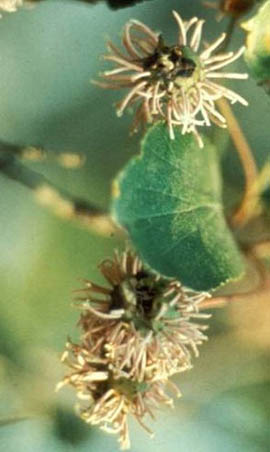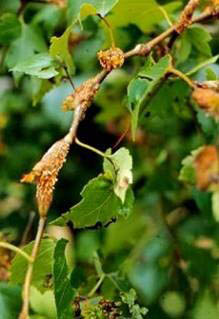Weird Growths on Hawthorn | |
|---|---|
| August 1, 2006 | |
Have you been seeing odd-looking fruit on your hawthorn tree? If it looks like the image below, it probably means the tree is infected with cedar–quince rust.  This disease usually does not cause any leaf symptoms on hawthorn but causes stem cankers and fruit infection. You can learn more about this disease in issue no. 3 of this newsletter. Many folks don’t notice the disease until it affects the fruit, so we are mentioning this again now, while fruit infection is evident. You should also see the swollen cankers on the stems. They are rusty orange at the beginning of the season but black by winter. An image showing the stem canckers on hawthorn follows. This disease usually does not cause any leaf symptoms on hawthorn but causes stem cankers and fruit infection. You can learn more about this disease in issue no. 3 of this newsletter. Many folks don’t notice the disease until it affects the fruit, so we are mentioning this again now, while fruit infection is evident. You should also see the swollen cankers on the stems. They are rusty orange at the beginning of the season but black by winter. An image showing the stem canckers on hawthorn follows.  Thornless cockspur hawthorn (Crataegus crusgali var. inermis) and Washington hawthorn are very susceptible to cedar–quince rust. We have not identified a hawthorn resistant to cedar–quince rust. Chemical options are available for disease control. Where problems have occurred in the past and resistance is not available, fungicides may be sprayed annually to prevent infection. The sprays must be applied before or soon after spores arrive on the crabapple or hawthorn. Most recommendations tell us to make the initial spray when crabapples are in pink bud and then to continue sprays through 2 weeks after petal fall. Read product labels for recommended spray intervals. The idea is to protect the plants from spores that are moving from junipers to the susceptible plants when those plants are most vulnerable to infection. If you have some infected junipers with rust galls, you can observe when the spores appear (bright color present). Protective fungicide sprays should be initiated at that time. There are many chemical options available in the Illinois Home, Yard, and Garden Pest Guide and the Commercial Landscape & Turfgrass Pest Management Handbook. For longer fungicide activity, a systemic product should be considered. Tables at the end of appropriate chapters provide mobility information on each chemical listed. | |
| Author: | Nancy Pataky |
